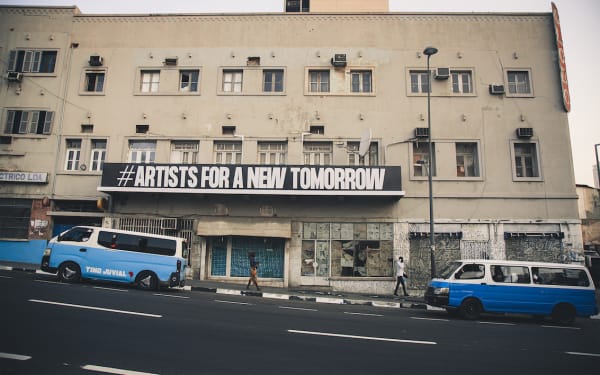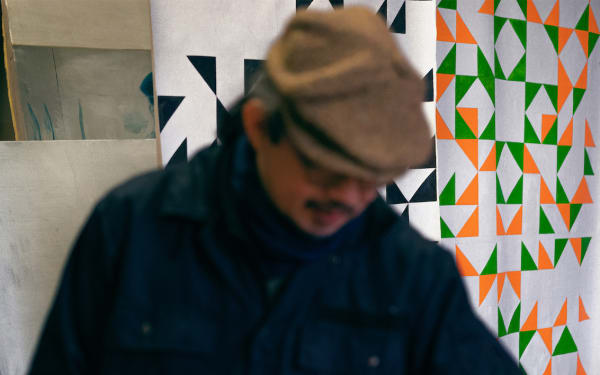Radical and radiant: These five artists explore queerness, intimacy, and tradition
Anchored in art history, their works will be featured in the upcoming Online Viewing Rooms
Melden Sie sich an oder richten Sie ein Benutzer*innen-Konto ein. So können Sie Art Basel Stories abonnieren und direkt in Ihren Posteingang bekommen.
Once considered a niche topic, queerness has become an essential part of contemporary cultural discourse. A look at ‘OVR: Miami Beach’ shows that the practices of many LGBTQIA+ artists echo artistic movements of the past, including Surrealism and New Objectivity. Figuration and traditional media such as painting and drawing abound, populated by disjointed, partially erased, or tortured bodies – perhaps a reflection of the challenges still faced by many members of the community. But not all queer artists use figuration to reassess the canon of art history, choosing instead tools such as appropriation and abstraction to do so. Here, we shed light on five of them.
In his collages, Troy Michie (b. 1985, United States) investigates both the fetishization and erasure of Black and Latinx male identities. A participant in the 2019 Whitney Biennial, he combines fabric scratches, swaths of saturated color, newspaper clippings, and pornographic imagery to create dense surfaces, where geometric patterns and human figures melt into each other. Michie often uses historic events to look at sexual and cultural identities. Stance / Pose and Waning Crescent (both works 2020) reference the zoot suit as a departure point for self-expression. In the 1940s, these boxy garments were popular in the African-American and immigrant communities of the United States; in 1943, a series of conflicts in Los Angeles, involving POC youth and the military, were even dubbed ‘Zoot Suit Riots’. Presented by Company Gallery, these layered works highlight Michie’s ability to illustrate the connections between fashion, sexuality, and culture.

Genesis Tramaine (b. 1983, United States) describes herself as a ‘female-bodied, contemporary Urban Expressionist, artist, and educator’. In Jezebels Son (2020), on view in Almine Rech’s virtual booth, a partially abstracted face occupies almost the entire canvas. The painting exemplifies the artist’s style, characterized by dynamic lines, saturated colors, and muscular gestures reminiscent of graffiti. Inspired by the people she encounters in her daily life, Tramaine’s work aims to capture Black identity while transcending gender and class. The Brooklyn native’s goal is to represent the community to which she belongs in all its complexity; desire and spirituality feature prominently in her energetic pictures. Her figurative practice owes a debt to both Basquiat's angular lines and Maria Lassnig's emotive self-scrutiny.

The figures in Anne Imhof’s (b. 1978, Germany) drawings also appear genderless. The German artist came to fame through her plays: durational performances featuring dozens of individuals interpreting her dance notations, notably Faust (2017) at the 57th Venice Biennale and more recently Sex (2019) at Tate Modern in London. The suite of drawings (all Untitled, 2020) presented by Galerie Buchholz, consists of sketches accompanying two plays the artist is currently working on. Some of Imhof’s figures appear otherworldly, missing eyes and ears; others are unmistakably human, sinewy muscles and sturdy hands clearly visible. Expressionistic tendencies combined with references to the pictorial worlds of H.R.Giger and Enki Bilal are evident. Limbs are elongated, disproportionate, faces expressionless or menacing, missing eyes and mouths. Dualities such as attraction and repulsion, presence and absence are central to the artist’s oeuvre, and these works on paper are no exception. Whether they depict embraces or fights we do not know for sure. What pervades them is a sense that both proximity to and distance from others seem desirable, yet never fully achievable.

Salman Toor (b. 1983, Pakistan) addresses similar themes of belonging and intimacy in his practice. Three works on paper by the artist, all from 2020, are presented in Luhring Augustine’s Viewing Room. Group D shows a group of people, standing closely together, heads down as if anxiously waiting for something. Joy emanates from Boy with Puppy, in which a young man cuddles a white dog. In a less realistic vein, Fag Puddle with Candle, Shoe and Belt shows a dislocated body spread on a table alongside the work title’s eponymous objects. Inspired by 17th- and 18th-century European painting, which he studied extensively, Toor reflects on his experience as a queer person of color in the United States, where he is now based. In these pieces, as well as in his current exhibition at the Whitney Museum of American Art in New York City, the artist uses art-historical symbols and compositions - candles, contrappostos, and pets, for example - to subtly punctuate this investigation of his own trajectory.

In a different register, Torey Thornton (b. 1990, United States) reassesses Postwar artistic movements and strategies, such as Abstract Expressionism and appropriation. Three of their works will be on view in ‘OVR: Miami Beach’, with Essex Street and Morán Morán. For How Many Ways To Understand Moving Image, How Many For Vanit (2018), the artist placed a found TV cardboard box and prints in a polished aluminum frame, lending the discarded materials an aura of glamour. The lines in Frankie, Bean, Tom, Odessa, Marisa, Liz, Taline, Susan, Alison, Nina, Marcel, Audrey, Camilla, Ingrid, Kat, Aaron, Lucy, Irina, Matt, Mara, Laura, Victoria, Irina, Lucy, Zsela, Carley, Kristie (2020) and Flagging, What constitutes itself as a stain to the constitution (wash) (2020), are reminiscent of Clyfford Still and Jackson Pollock. This radical eclecticism can leave the viewer puzzled – a reaction which interestsThornton. ‘I was always really fascinated by the mysticism and the surprise of a work. When you come and you see this new thing, there’s a rush of emotional stimulation, whether you like it or not,’ they explained in a 2019 interview with Artnews. It can be arduous to categorize Thornton’s work as belonging to a specific medium or movement. But it is precisely this evasiveness and fluidity that resonates so strongly with current discourses around gender and sexual identities.

‘OVR: Miami Beach’ opens for invited VIPs on Wednesday, December 2, 10am ET. Public days will follow from Friday, December 4, 10am ET through Sunday, December 6, 12 midnight ET.
Top image: Troy Michie, Stance/Pose (detail), 2020. Courtesy of the artist and Company Gallery, New York City.




